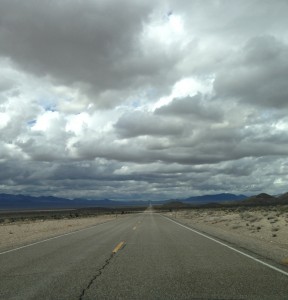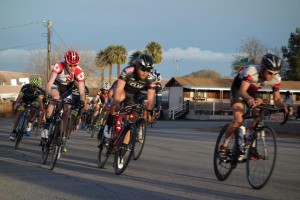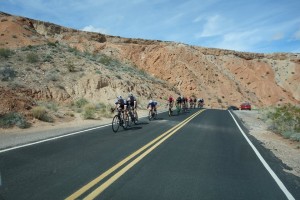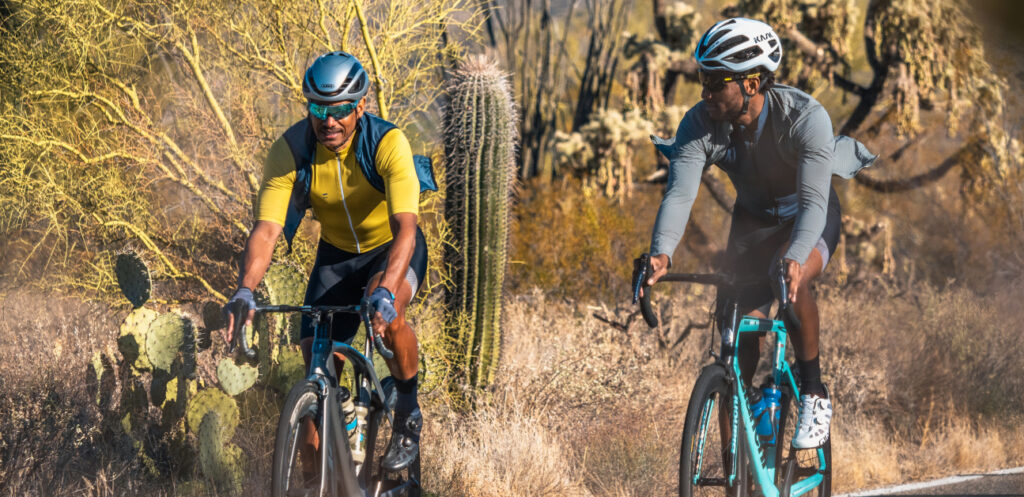Lessons from The Valley of Fire
 I’d love to pretend that once I learn a lesson I can then catalog it away and know that the information acquired will automatically inform future decisions and effortlessly steer future actions. Ah, if only that were the case. Too often, I find myself repeating mistakes I’ve made in previous races only to endure an exponentially sharper sting from these recurrent oversights & missteps.
I’d love to pretend that once I learn a lesson I can then catalog it away and know that the information acquired will automatically inform future decisions and effortlessly steer future actions. Ah, if only that were the case. Too often, I find myself repeating mistakes I’ve made in previous races only to endure an exponentially sharper sting from these recurrent oversights & missteps.
Last weekend’s The Valley of Fire Stage Race in Overton, NV, served as the kickoff to my 2014 race season and it was frought with far too many of these repeat lessons. Having won this race (or its then current incarnation) way back in 2008 when it was more blandly titled the Southern Nevada Stage Race, I traveled south with the possibility of surprising myself again with early season fitness beyond that of my competitors – not this time.
Instead, my early season trip turned out to be everything I’d anticipated in 2008 – an opportunity to assess my own strengths & weaknesses very early in the year, a glimpse at some of my competitors and their current form, a chance to bury myself in the fatigue inherent in 3 closely stacked bike races, and a stage-racing dress rehearsal to iron out some of the logistical, nutritional & equipment-related challenges that crop up when you utilize multiple bikes, myriad wheels and countless items of clothing ranging from cold-weather layers to aero-enhancing gear of all sorts. Done, done & done!
And as I previously alluded, I had the good fortune/misfortune of learning some new lessons and repeating a handful of previously learned ones. So here goes…
Time Trial
Lesson 1: Pre-riding a TT course is always a good idea, but when the course is especially short, the pre-ride becomes essential.
The VoF’s TT course was a short 3.1 mile out & back trip – 6.2 miles total – in increasingly wet conditions. On top of the chilly rainfall, the road was rough, occasionally sharply uphill, and contained a couple of sharp and/or downhill turns which pulled me unnecessarily out of my aero bars. I say “unnecessarily” because a pre-ride would have shown me that I could have handled these turns in my aero position by simply slowing my spin heading into them. A pre-ride would have demonstrated that a few seemingly blind corners had safe exits thus keeping me from easing off the gas unnecessarily. A pre-ride would have installed confidence in place of my frequent surprise. Simply, a pre-ride would have shaved some seconds, and in a race where the margins were tiny, a pre-ride could have been the difference between finishing 14th and finishing within the top 10.
Lesson 2: Races are never the best time to try out new equipment.
Who hasn’t heard this? But when circumstances arise such that your TT bike isn’t made available until 2 days before your race, well, you simply have to roll with it and accept that your subsequent time trials are probably only going to be better ones.
Lesson 3: If it’s cold & wet, staying warm right up to your minute of departure is imperative.
50-ish degree temperatures are manageable, mild to not so mild rain is manageable, but both combine to make some potentially bone-chilling conditions when your concern for aerodynamics overrides your desire to stay warm. Time trials are spent in minimal clothing – skinsuit, shoes, helmet. No gloves, probably no sleeves unless you ponied up for the pricier suit, and certainly no baggy, warming layers…anywhere. But up until the minute prior to your start, keep your jacket on, maybe even keep some full-fingered gloves on, then strip ’em off and ditch ’em while your 30-second man is getting his 5-second countdown.
Criterium

Lesson 1: Clear objectives can make the difference between doing too much work and doing just enough work.
When the field is small and fast and the course is non-technical, only the most motivated and properly comprised breakaways is going to get away. Knowing this and knowing that you still have a 72-mile road race tomorrow means the field will probably finish as it starts – as a single group. With this in mind, your objective shifts to conserving energy and avoiding crashes which means staying up front, staying close on the wheel in front of you at all times – fast corners and faster straightways – and avoiding needless risks which aren’t going to move you up the general classification anyway.
Lesson 2: Know your race leaders.
As long as any 1 of the leaders is contained in the field, it’s safe to assume the others are as well. The top 3-5 riders know very well who their prime threats are and they’re ceaselessly aware of the positions of one another. Learn their numbers, their kits, their helmets, then if you see one, it’s safe to assume that the others are nearby. If one of them marks a move then it’s safe to assume you should mark that same move or risk an increased time gap between you and the GC leaders should that move get away.
Lesson 3: Pay attention, constantly.
I’ll expand more on this in my road race lessons below, but it only takes a moment of distraction to cause, or get hung up in, a senseless crash.
Road Race

Lesson 1: Make friends at the starting line.
Alliances in amateur bike racing are perhaps less pronounced than in the pro ranks but they’re no less beneficial, utilized & welcome. For most amateur riders, racing is about the sheer enjoyment of riding & racing bikes while podium spots, merchandise & small cash prizes, and points rankings & titles serve as the rewards. There are no paychecks on the line, no contracts that evaporate when you fail to deliver results. And when it comes to masters racing the motivation of prize money isn’t even that high since most of us have full-time jobs which leaves racing as a pure labor of love.
So make friends! Most amateur riders are friendly and easygoing. Learn names, learn teams, get a bit of background, and above all, help others out when the opportunities arise because, without a doubt, you will need their help at some point in time. Should you ever find yourself short on that form of support, you’ll only have yourself to blame.
Lesson 2: Remain ever-vigilant.
Mishap is an opportunistic bastard just waiting for that single moment of distraction – that brief glance down at your gears, that too-long rummaging for a gel – or those brief moments of complacency – the too-light hands on the bars when the pace temporarily mellows, the relaxed feeling you indulge after a 50mph descent has ended.
Crashes happen regardless of how keenly aware you remain, but the fact of the matter is that most crashes happen because riders lose focus.
Lesson 3: Compensate for your deficiencies now, address them later.
Heading into the road race, I knew full well that my weight was on the high side and my sustainable power was on the low side. I also knew how I planned to further address these concerns once the race weekend was behind me. So my concern shifted to limiting the damage the field would inflict on my body over the course of the rolling and more sustained climbs.
Sadly there comes a point where starting the climbs at the front of the field and drifting to the back over the course of the climb turns into chasing onto the back of the field just in time to watch them slay another climb at a power output you couldn’t muster if a bear were chasing you. You soon understand all too well that you can only chase back onto a field so many times before your legs refuse to indulge your idiocy any further, you can only yo-yo off the back of the field during the race’s latter, yet still quite steep, rollers so many times before your body won’t forgive your insufficient fitness any longer.
Bonus Lesson: Weight loss & increased muscle endurance are diametrically opposed training outcomes.
Tied to Lesson 3 above, it’s looking more & more like you can have one or you can have the other, maybe even pale shades of both at once, but having fielded a lot of questions lately from riders looking to lose a few more pounds as they suffer through a Build cycle, my stance on this issue hasn’t changed. In fact, it’s only gained stronger footing as I’ve personally paid the price for trying to walk this particular tightrope.
And here it is: choose one. You can focus on weight loss, you can focus on improving your muscle endurance, i.e. time to exhaustion while riding near FTP; but if you attempt to focus on both then one will come at the expense of the other. This isn’t to say you can’t have both simultaneously to lesser degrees, but only because one will come as a result of the other. For example, lower body weight can increase your strength to weight ratio, i.e. W/kg, and seemingly your FTP, while high-power workouts near FTP burn a lot of calories thereby possibly trimming a little fat; however, it’s highly unlikely you’ll see substantial weight loss during a sizable FTP ascent because the efforts required to lift FTP, especially on a time-constrained training schedule, require plenty of fuel.
My Gift to You, Your Gift to All
With all of this cataloged away and, I hope, a little closer to my mind’s surface as well as yours, here’s hoping you’ll benefit from my mistakes – repeated & first-time – rather than have to endure them yourselves.
If you have any lessons to share, please chime in and possibly spare your fellow TrainerRoad riders the pain, embarrassment or grief you’ve so kindly experienced such that we might not have to.
Until next time, train smart, ride hard & have fun.
